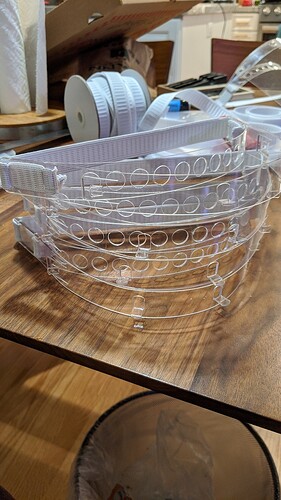We started making the headbands for the Proto Shield medical face shield on our Glowforge to donate to hospital ICUs (the 020 PETG faceplates are being cut elsewhere):
https://www.protohaven.org/proto-shield/
It’s a laser-only face shield designed to be functionally equivalent and part-compatible to the Prusa Shield that everyone is 3D printing right now, except 100x faster because laser. It uses 060 PETG.
Some observations based on our experience:
- After much trial and error, we found the best Glowforge settings were:
3 passes: 375 speed / 100 power / 0.06in Focus Height
1 final pass: 500 speed / Full power / 0.03in Focus Height
With these settings the 060 did cut beautifully. I think slightly thinner PETG can still work but be less terrible, because…
- 060 PETG is incredibly temperamental. If you over laser it by the slightest bit—a little too slow, a little too much power—the cuts will begin sealing together.
The fumes are also pretty intense and no doubt toxic.
- Assembling the headband was kind of tricky. I was hoping that being a laser-only design would mean you could ship it out flat for assembly elsewhere, but IMHO it’s complicated enough that I would be hesitant to send the cut pieces for random strangers to assemble unless they were an experienced crafter / maker.
The peg-bending parts were the trickiest. You can easily break the band if you’re not careful.
- Re: the gaps in the peg holes
With the laser headband, where you bend the attachment pegs out it creates a small hole in the headband that is solid in the Prusa headbands. Eric from Maker Nexus mentioned that as a point of vulnerability.
Since I want to get this batch out ASAP I taped over the back of each peg hole as a stopgap measure.(literally! lol)
After some research I think taping over the holes with 3m Polyester Film Tape 850 would be a good solution in the future. It’s strong, permanent, temperature and chemical resistant, and designed to be used on polyester—which is what PETG is. Closing the holes with silicone may also be a good option.
- Elastic: They’re using button elastic in the Protohaven example pictures. Maybe 3/4" button elastic is narrower than the no-roll 3/4" elastic I have, because 5/8" elastic is a more appropriate size for the slots. I widened the slots a tiny bit on my template because I was having to use pliers to smash the elastic through initially.
While technically removable, it would be a pain to have to remove and reattach it all the time for disinfection (as it’s designed to do on the 3D printed Prusa shield), and I’m honestly not sure how well the elastic would hold up. The elastic is also what holds the two pieces of the headband together.
I think the template should be modified so that the elastic isn’t the only element holding the two parts together, so the elastic can be more easily slipped on and off for disinfecting.
-
Once you get the settings down, you can really churn them out VERY quickly, like several orders of magnitude faster than with a 3D printer (which i was told takes 1.5 hours to print the parts for one shield). We could make a couple hundred headbands a day just on our little Glowforge.
-
Overall, I think this is a pretty ingenious (and way more efficient) functional equivalent to the Prusa 3D-printed headband, especially once you close the gaps behind the pegs. The visors for each shield are compatible.

